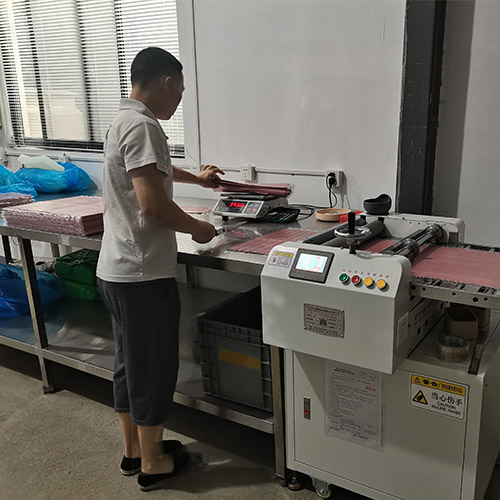Silicone rubber keypads are widely used in consumer and industrial electronics due to their unique soft texture and diverse designs. However, have you ever wondered how these sturdy and durable silicone rubber keypads are made? In this article, we will take you into the manufacturing process of silicone rubber keypads and let you understand the process.

Raw material selection
A silicone rubber keypad's key step is choosing the right raw material. Silicone has excellent heat resistance, non-corrosive, electrical insulation, and other properties, making it widely used in electronics, automobiles, medical aviation, and other fields. Using raw materials with specifications and standards can ensure the quality and reliability of silicone rubber keypads.
Mold design
After the raw materials are prepared, the next step is to design the mold. A complete mold design can ensure the quality of the silicone rubber keypad produced. A mold is a key tool for molding silicone rubber keypads. Generally, the mold is processed according to the keypad drawings provided by the customer. Sometimes the sample is copied to obtain a 3D drawing. For mold design drawings that are not specially marked, the surface of the mold is generally treated with diamond sand. Before batch production, the mold is tested to confirm the structure and post-processing process.
Material preparation
After the mold design is completed, the next step is batching and mixing. According to the production specifications, the correct specifications of silicone pigments, and other additives are mixed in precise proportions and stirred evenly in an open mixer or internal mixer to ensure that all raw materials are fully integrated. The next step is to slice the customized silicone and wrap it with PE film. This step is critical because the batching ratio directly determines the quality and performance of the silicone rubber keypad.
Molding vulcanization
After the ingredients are mixed, the sliced and weighed silicone raw materials are manually placed into the empty mold cavity one by one, and the mold is closed after preparation. Under continuous heating and pressure, the silicone raw materials gradually solidify and form a silicone rubber keypad. The time of this process may be from a few seconds to a few minutes. Molding vulcanization is one of the most critical processes in the production process of silicone rubber keypads because this process determines the final shape and performance of the silicone rubber keyboard. In addition, the control of temperature and time is the key to the dimensional accuracy of the silicone rubber keypad.
Secondary vulcanization
The vulcanized silicone rubber keypad is a semi-finished product. Sometimes, to meet design requirements or improve product performance, the semi-finished product is placed in an oven to remove the residual vulcanizing agent decomposition products in the silicone rubber keypad. The vertical oven baking temperature is usually set to 180-200℃. Depending on the requirements of different customers, the process generally lasts 2-4 hours.
Post-processing
After vulcanization, the silicone rubber keypad has taken shape. According to the design requirements of the drawings, the keys need to be post-processed such as surface treatment, trimming, and inspection to ensure that the appearance and performance of the silicone rubber keypad meet the original specifications.
Silk screen printing, spray painting, laser engraving
Next, the product's surface is silk screen printed, sprayed, and laser etching according to the customer's requirements for the surface processing of the silicone rubber keypad.
Screen printing
For the character design requirements on the key surface, the screen and ink with the correct mesh must be selected for screen printing. Before batch screen printing, the first version needs to be confirmed by quality inspection before further printing. Unqualified products can use solvents to wipe off the characters on the key surface. Products that pass the screen printing will be placed in a baking oven or tunnel furnace for ink curing.
Paint spraying
Sometimes, according to the design requirements of the drawings, the surface of the silicone rubber keyboard is sprayed with color oil, matte, PU, and other inks. After completion, the semi-finished product is sent to the baking equipment for curing within the standard time. After baking, it is inspected on-site. Unqualified products will be reworked or scrapped. Flawless products will enter the next process.
Laser etching
Convert the design drawings into the required format of the laser etching machine and perform laser etching on the surface of the silicone rubber keypad.
Punching, self-removal
Choose punching or manual self-removal to remove the excess burrs, making the surface of the silicone rubber keypad more beautiful.
Process control
Process control during vulcanization molding
The main inspection items in this process are size, elasticity, color difference, elasticity, stains, and material shortage. If the defective ratio exceeds the limit, timely feedback should be given to the production department.
Quality control during silk-screen printing
During the silk screen printing process, white oil and other solvents can be used to wipe off defective products due to ghosting, unclear fonts, poor wear resistance, etc., and the silicone keypad can be reprinted after it is naturally dried.
Finished product quality control
100% inspection of products that have completed all processes to ensure that the silicone rubber keypad meets the shipping standards before packaging.
The above are the steps involved in the production process of silicone rubber keypads, from raw material selection to post-processing. Each step will undergo strict quality control to produce high-quality silicone rubber keypads.

